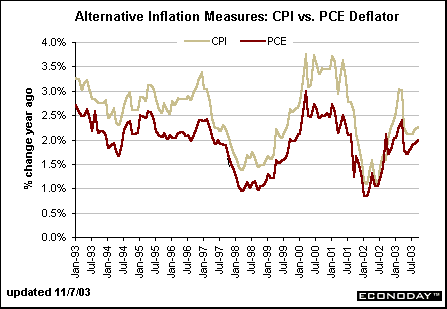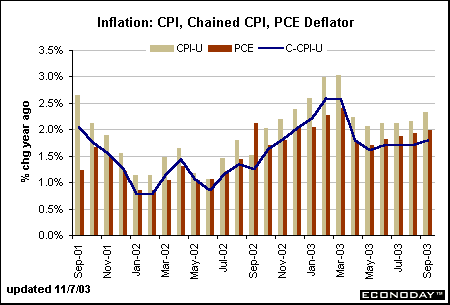 |

Long Term Perspective
Inflation is always a key indicator among Fed officials. Although the CPI is the most common inflation measure, Fed chairman Alan Greenspan prefers the personal consumption expenditure (PCE) deflator. He believes the latter is more representative of changes in the actual cost-of-living. The discrepancy between the PCE deflator and the CPI widened throughout 2000 and the first half of 2001 perhaps showing a greater shift in the composition of goods and services actually purchased by consumers (towards lower-priced commodities). The PCE deflator incorporates most of the CPI components. Nonetheless, it shows less inflation than the CPI because it also takes into account the fact that consumers substitute lower priced goods for higher priced goods as relative prices change. For example, when the price of chicken falls relative to the price of beef, consumers will buy more chicken. Thus, their actual food costs probably didn't increase as much as indicated by the CPI, which measures a fixed basket of goods and services, and doesn't allow for substitutions.

Short Term Perspective
In 2002, the Bureau of Labor Statistics (BLS) introduced an alternative measure of the consumer price index, called the Chained CPI. It differs from the regular CPI in that it is not a fixed basket of goods, but one that changes over time, akin to the PCE deflator. Fed chairman Alan Greenspan has mentioned this index several times in the past year and clearly favors it over the regular CPI since it is a more accurate reflection of changes in the cost-of-living. Since historical data is only available to 2000, the BLS can't yet adjust this index for seasonal variation. The chart below depicts the year-over-year change in the unadjusted CPI, chained CPI, and the seasonally adjusted PCE deflator (since the unadjusted version is not readily available). Notice that the yearly changes in the chained CPI (C-CPI-U) are very similar to those of the PCE deflator since 2001.

 |


Alternative Inflation Measures • Gold Prices • Employment Cost Index • Civilian Unemployment Rate

Pool of Available Labor •
Nonfarm Productivity • Treasury Yields • Stock Prices • Fed Monetary Policy Summary
|
 |